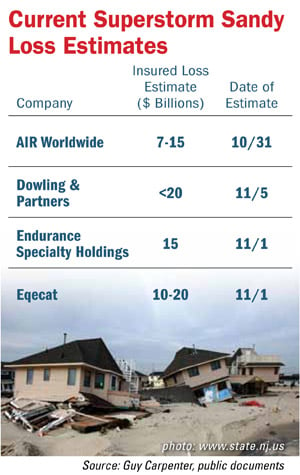Despite the high winds recorded from Superstorm Sandy, actual wind damage from the storm was “surprisingly minor,” a report from reinsurance broker Willis Re says.
Willis Re, a subsidiary of Willis Group Holdings, issued its Hurricane Damage Survey report last week saying the storm had estimated sustained winds of 80 mph when it made landfall near Atlantic City, N.J., at 8 p.m. on Oct. 29.
 The storm “became complex when interacting with another weather system to the west, creating a large superstorm.”
The storm “became complex when interacting with another weather system to the west, creating a large superstorm.”
Recommended For You
Want to continue reading?
Become a Free PropertyCasualty360 Digital Reader
Your access to unlimited PropertyCasualty360 content isn’t changing.
Once you are an ALM digital member, you’ll receive:
- Breaking insurance news and analysis, on-site and via our newsletters and custom alerts
- Weekly Insurance Speak podcast featuring exclusive interviews with industry leaders
- Educational webcasts, white papers, and ebooks from industry thought leaders
- Critical converage of the employee benefits and financial advisory markets on our other ALM sites, BenefitsPRO and ThinkAdvisor
Already have an account? Sign In Now
© 2025 ALM Global, LLC, All Rights Reserved. Request academic re-use from www.copyright.com. All other uses, submit a request to [email protected]. For more information visit Asset & Logo Licensing.








